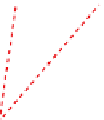Environmental Engineering Reference
In-Depth Information
N
2
O
N
2
NH
3
NO
Urea
NH
4
+
NO
3
-
Soil
Organic
Matter
NH
4
+
NO
3
-
N
2
O
N
2
Nitrification
Denitrification
FIGURE 12.2
Expected pathways of nitrogen fertilizer transformations and losses. Most fertilizer nitrogen
enters the system as urea, which is then rapidly hydrolyzed to ammonium. In the absence of plant uptake (the
typical situation, given that most of the fertilizer is added before planting), ammonium (NH
4
) is volatilized to
ammonia (NH
3
) or oxidized by nitrifying bacteria under aerobic conditions to nitrate (NO
3
). During nitrification,
some portion of nitrogen is lost in the trace gas forms of nitric oxide (NO) or nitrous oxide (N
2
O). Nitrate in the
soil can be leached in soil solution to depths below the rooting zone, or can be reduced to N
2
O or to dinitrogen
(N
2
) by denitrifying bacteria. All of these processes occurred in the Yaqui Valley soils.
ecosystems of the Sierra Madre, but our search for funding to study the amounts and con-
sequences of the deposition was never successful.
Through a combination of measurements under varying soil conditions and with the use
of
15
N analyses, we identified the biogeochemical pathways that controlled the loss of nitro-
gen from the fields to the atmosphere, showing clearly that a significant portion of the trace
gases lost following fertilization is produced by nitrification rather than denitrification pro-
cesses in these ecosystems (
Panek et al. 2000
). While microbial ecologists recognized the
potential role for nitrification in emissions of both NO
x
and N
2
O, most field-based studies
assumed that N
2
O measured at the soil
air interface was related to denitrification. The dis-
covery that nitrification could be an important source under some conditions carried impli-
cations for the management of gas fluxes in agricultural sites around the world.
We also tracked nitrogen losses through water systems. Lysimeter studies coupled with
a multilayer biogeochemical model called NLoSS indicated high fluxes of nitrate though
soil to below the rooting zone (
Riley et al. 2001
). While we wished to evaluate subsurface
transport from fields through riparian areas to the “drainage canals” (natural streams and
human-made drainage canals) that drain from the agricultural lands directly to the sea,
we failed to get funding and thus never measured (or quantified) those fluxes. However,
we did study transformations of nitrogen in the drainage canals themselves, measured
extremely large fluxes of nitrous oxide (
Harrison and Matson 2003
), and uncovered the
crucial role of extremely rapidly changing oxygen conditions in controlling them
(
Harrison et al. 2005
). Moreover, we carried out a remote sensing-based study to illustrate
the synchrony between irrigation and fertilization events on land and enormous phyto-
plankton blooms in the open waters of the Sea of Cortez (
Beman et al. 2005
), and delved
deeply into the physical, chemical, and microbial controls on nitrogen processing and
transport in the coastal waters. In the end, our research illustrated the land-to-sea move-
ment of
fertilizer nitrogen, and consequences of
those fluxes for the oceans and







































